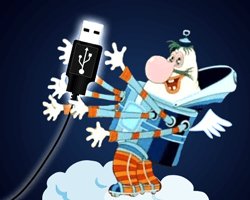Connecting peripheral devices to the cloud
- Home
- Blog
- Technical Support
- Connecting peripheral devices to the cloud
Modern cloud technologies have completely changed the world around us. They have even affected conventional offices – terminals and thin clients have replaced ordinary computers, computing has migrated to the cloud, and an employee does not need to be at their workplace every day from 9 to 18, since they can work from anywhere, even from home, a cafe, even from a beach in a remote tropical country. The benefits of this approach are obvious to everyone – it is both savings on software and equipment, and greater mobility of employees, and the ability to work on documents collectively, and much more. Therefore, cloud technologies are increasingly gaining popularity, not only among startups but also among conservative companies.
A standard workplace in a cloud-based office looks like this:
- terminal server – the "core" of the system, which contains all the necessary user software, tools for accounting and monitoring users' work, and other necessary functions. At the same time, the server can be physically located even on the other side of the globe. The key thing here is to have uninterrupted network access to it;
- thin client or other terminal access device with a minimal configuration (an old computer, laptop, tablet, phone, etc.);
- peripherals required for operation (external storage devices (HDD, USB flash drives), keys, headsets, multimedia, printers, scanners, MFDs, etc.)
Companies that are just going to implement such technologies are concerned about many things, including the following: how to connect peripherals so that they are accessible to all employees, how to work with removable media and electronic keys, how to organize printing, etc. This material will help with this and other similar questions.
Working with printers in the cloud: connecting, configuring

Ordinary network printers today will not surprise anyone – they have been working properly for many years, even in the smallest offices. With printers in the cloud, everything is quite similar, but there are also some specificities. First, to use a printer, it must be accessible, otherwise, there is no point in using it (except in cases, for example, when a colleague from a geographically remote office needs printouts). Secondly, it must support one of modern cloud printing technologies or have its IP address in a network, visible to other elements of this network.
The easiest and most convenient way to connect the printer to the cloud is to use one of the external services like Google Cloud Print. Of course, the device must support this technology, and most modern models support it. Different manufacturers may have different names for this technology, for example, HP calls it ePrint. The setup is quite simple: you will need a Google account, for linking the printer to a virtual print server. Immediately after linking, you can send documents for printing. All settings such as adding users, print quality, format, and others are made through a user-friendly web interface. An important advantage is the ability to print directly from Android devices with an OS version not lower than 4.4 KitKat.
If for some reason, you do not want to use external services, you can configure the connection to the printer manually via a TCP/IP protocol. To do this, it must have an external IP address, which is possible if the printer supports it on the hardware level, or when using a separate print server. The printer is installed by standard means of Windows or another OS on the terminal server, and its IP is specified as the path. After completing the setup, the printer will be available to all users in the cloud.
Connecting external storage media (flash drives) and electronic keys

Usually, there are no problems with flash drives since most thin clients have a required connector that allows you to use external drives. If there are no such connectors, a flash drive can be connected to a server, and access to it is provided via USB-over-Network – a special technology that allows you to share any connected devices.
Sometimes there are some issues with hardware license keys for such programs as "1C Accounting", "Liga Zakon" and others that require a connected USB device that confirms the right to use the software. However, these issues are solved quite easily. This will also require the USB-over-Network software, which is better to install in advance. After that, the key is connected to the server, then it is shared with the clients using a VPN tunnel or another way. After that, you will only have to make sure that 1C on the terminals successfully recognizes the key connected in this way.
It is also possible to use the option of key forwarding using USB-over-RDP, but this is only suitable for one-time operations since the connection breaks along with a terminal session. More detailed instructions on the use of electronic keys are offered by software manufacturers themselves.
The installation of other USB devices

Support of a direct connection of peripherals to a thin client depends primarily on the availability of drivers "embedded" into it. So, if the driver is supported, a device will be recognized and will work. Modern operating systems used on thin clients allow you to connect many different peripherals, at least in compatibility mode. So, it is possible to set scanners, multifunction devices, web cameras, and other similar devices. If you cannot connect them directly, you can use the USB-over-Network connection mentioned above: the device will be physically connected to the server, and for the clients, it will be visible as local, and you can use it in full. If there is a need to work with non-standard devices, try to choose newer models, so it is more likely that they will have the support of cloud services, and you will have fewer difficulties with their configuration.
Often, an RDP client is used to connect to a terminal server in the cloud. If pre-configured security policies allow such connections, most of these clients automatically "forward" the connected peripherals to the server and there are no problems in their operation. If difficulties arise, it is usually because the user independently changes settings or connects new devices.
Stable operation of peripheral devices is often critical for working with applications, for example, for financial reporting (1C-Accounting) or CRM systems with electronic keys. A Finance Department will not be able to fully work without a printer, and a Commercial Department without a customer relationship management system, so if you plan to place applications in the cloud, pay attention to the services TuchaBit, TuchaBit+ and TuchaFlex+. Our specialists will help you configure all systems and connect devices, and you will get the ready-to-use service.